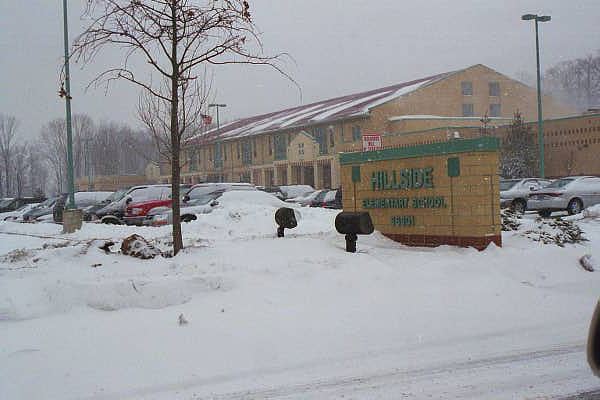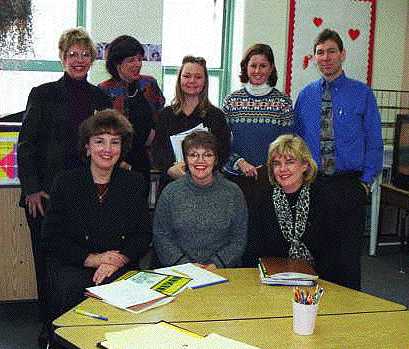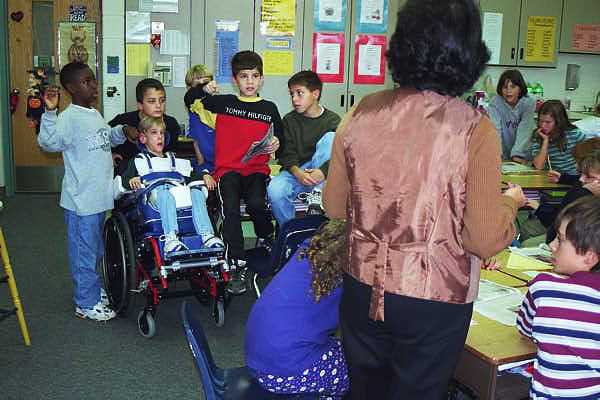
Hillside Elementary School
36801 West 11 Mile Road
Farmington Hills, MI 48335
248-489-3773
Principal: Dr. Janice Colliton
Students: 586*
% Free/Reduced Lunch: 3.8%*
Hillside
Elementary School
36801 West 11 Mile Road
Farmington Hills, MI 48335
248-489-3773
Principal: Dr. Janice Colliton
Students: 586*
% Free/Reduced Lunch: 3.8%*
The Community-
Farmington Public Schools serves students in Farmington, Farmington
Hills, and a portion of West Bloomfield. These communities are
near suburbs of the city of Detroit and are located Northwest
of the city in Oakland County. All of these communities are considered
high middle to high-income areas. Farmington Hills, for example,
in 1989 had a median household income of $51,986. Driving through
these areas, we see spacious houses in well-groomed yards. Many
families have professional and managerial white-collar positions
and a substantial portion of the population has graduated with
a higher education degree. However, there are pockets of poverty
in these communities, as evidenced by the 3.8% of students who
qualify for free and reduced lunch.
The School-
Hillside is part of the Farmington Public School District,
and has a total K-12 enrollment of 12, 063 students. The school
building is in a residential area, and it is fairly new having
opened only nine years ago. There are four classes per grade level.
It is spacious and well designed. The district's mission statement
is: "...together with our community, (we) will provide quality
learning experiences empowering each student to become a thoughtful,
contributing citizen in a changing world."
The district's 2007 Mission Beliefs are stated as: learning is a lifelong process, individual responsibility is fundamental to learning, there is strength in diversity, positive relationships enhance effectiveness, effective communication is key to growth and understanding, working cooperatively enhances individual and group performances, all individuals have unique gifts and talents, change provides opportunities for growth, a commitment to quality requires a system to continually improve, and learning empowers and all individuals can learn. **
Hillside's mission statement is as follows: "We believe that all students can learn and that learning is enhanced by a combined effort of school, family and community. Students learn best in an environment which integrates curriculum, is developmentally appropriate, and addresses diverse intelligences, learning styles and interests. Students will develop respect for self and others and become cooperative, contributing citizens of a technological society." **
School Change and Improvement:
The Farmington Public Schools developed a 10-year plan for
the improvement of elementary schools in the system. Priorities
in this plan include: diversity, inclusion, multi-age. Each elementary
school is charged with selecting an area of focus for improvement
each year over the next ten years. In 1998-1999, Hillside selected
inclusion as a focus. Teachers and other staff in the building
have had training in a wide range of teaching innovations.
Empowering Citizens in a Democracy-
The school administration attempts to support teachers in engaging in change and improvement by involving them in team decision-making. Teachers may take initiatives and obtain support and input of the principal. The faculty elects a 'Teacher-Leader' position who serves in a supportive role in many school projects and serves as a liaison between the principal and teaching staff.
At the classroom level, students participate in the development of classroom rules and learn to be part of a team through the use of cooperative groupings in many classes throughout the building. Many teachers use multiple strategies to involve students in decision-making and in having an active role in the conduct of the class. The student council gives students an opportunity to practice leadership skills. Several monthly community service projects also provide the chance to practice citizenship skills.
Include All-
Students are largely white in the building though there is
a wide diversity of ethnic groups and native languages. Students
in many classes receive bilingual services. There are a small
number of children of color in the school. However, this is rapidly
changing.
The school has made efforts to include gifted and talented students with students who have mild disabilities. Several students with autism and a student with a severe, multiple disability are included in classes with support of paraprofessionals.
 There are two special
education classrooms in the building referred to as "Learning
Disabilities" classes that serve students with severe learning
disabilities and students with educable mental impairments. Students
in these rooms are mainstreamed into 'specials' and, increasingly,
into academic classes for a substantial amount of time during
the day. The school staff has engaged in discussion regarding
the need to facilitate the inclusion of these students and teachers
are developing ways of including these students in general education
classes.
There are two special
education classrooms in the building referred to as "Learning
Disabilities" classes that serve students with severe learning
disabilities and students with educable mental impairments. Students
in these rooms are mainstreamed into 'specials' and, increasingly,
into academic classes for a substantial amount of time during
the day. The school staff has engaged in discussion regarding
the need to facilitate the inclusion of these students and teachers
are developing ways of including these students in general education
classes.
Students with moderate to severe disabilities are served at separate schools and classes in other buildings throughout the Farmington Public Schools. As of this writing, school staff are seeking to locate these students.
The school psychologist and other support staff report that referrals for special education are lower in this building than in other schools in the district. They attribute this to the supportive instruction and in-class supports provided.
Teacher ability group students in several ways in instruction. In the early grades, an early intervention literacy team comes into K-3 classes 2-3 times per week. 4-5 adults split the class into small groups of students who are engaged in a prescriptive program of literacy instruction involving phonics, common readings in simple books, and other related strategies. Children are grouped by ability. During these times the special education co-teacher works with the identified special education students in a class. Students with different categories of special needs gifted, special education, bilingual are clustered in classes to facilitate support services by specialists to teachers.
Authentic Instruction and Adapting for Diverse Learners.
The staff has received training in multiple intelligences, instructional differentiation, bilingual education, cooperative learning, co-teaching, and alternative assessment strategies. Observing in classes, we see many teachers who are using multiple approaches to designing and implementing engaging lessons. Walking down the hall you see writing and drawings of student's personal lives, research they have conducted. Students are often working in small groups or pairs in the hall. Teachers use cooperative learning, inquiry-based projects, activity-based learning, and authentic reading and writing strategies. Many teachers have implemented alternative assessments such as portfolios and some teacher has begun to implement student-led parent conferences. The school offers a unique program of optional special interest classes in the late afternoon which aides in providing a range of opportunities for students. In addition, the school has a full program of art and music.
The school is working to develop strategies for accommodating
students with learning challenges. They have been trained in 'collaborative
consultation' where teachers and support staff together look at
problem students have in the classroom and develop instructional
modifications. Teachers and administration report that this process
has been very helpful to them. The school staff are engaging in
dialogue and work to further multi-ability teaching to assist
in expanding inclusion in the school. 
Building Community and Supporting Learning.
The school has a wealth of resources to provide support for
student learning. Two special education teachers are co-teaching
with several teachers to whom they are assigned. The school has
clustered students with mild disabilities, autism, and severe
disabilities in an attempt to aide in the management of support
staff time. Staff are continuing to experiment and learn regarding
general and special education teachers collaborating via co-teaching.
Similar specialists are available for bilingual education and
gifted education.
A school psychologist also serves in a dual role as a parent / community facilitator and liaison. She helps develop programs to promote drug and violence prevention that include support groups, drug and violence prevention information programs, and others.
An Early Intervention Team works in the lower elementary grades to provide intensive services to support literacy skill development of students.
Parent and Community Partnerships.
Parents are involved in school improvement decisions through
the district-wide School Improvement Steering Committee as well
as each school's School Improvement Goal Committee. The school
has a very active PTA and the building houses a Parent Volunteer
Lounge. The PTA supports and encourages extra field trips, enrichment
assemblies, family fun nights and the Science Fair. Parents volunteer
in classrooms, the media center and on district curriculum committees.
HILLSIDE ELEMENTARY SCHOOL
Statistical Data
Farmington Hills
Farmington Hills, a primary community for the Farmington Public Schools, is a fairly homogeneous population: 74,652 as of the 1990 census, most of this population being White (70, 061). There are 1,343 Blacks, 107 Native Americans, 2, 865 Asians, and 276 listed as Other. The Asian population consists of a mix of Chinese (374), Filipino (490), Japanese(455), Asian Indian (1173), Korean (179), Vietnamese (10), Thai (9), and 175 Other Asians.* It should be noted that the city is rapidly changing in demographics to include many more minorities than reported in 1990 census. This comes from personal observances in the school studied, as well as reports from the principal.
The median household income in 1989 was $51,986. Industries are widely diversified with the leading ones being: health, education, and other professional services, retail trade, the manufacture of durable goods, finance, insurance and real estate services, business and repair services, and construction. Over 18,000 persons are employed in managerial and professional occupations, about 7,000 in sales occupations, 6,000 in clerical and adminstrative support occupations. *
The educational attainment for the city breaks down like this for persons twenty-five years of age or older: 1,663 have less than a 9th grade education, 3,898 have a 9th-12th grade level of education but no diploma, 10,320 are high school graduates or the equivalent, 10,460 have some college education but not a degree, and over 25,000 have an associates degree or higher.*
Special education in Farmington Public Schools.
Special Education: In the 1998 school year, the Farmington Public School District had the following numbers for special education students: 62 educable mental impairments, 27 trainable mental impairments, 26 severe mental impairments, 195 emotional impairments, 445 learning diabilities, 5 hearing impairments, 5 visual impairments, 142 physical and other health impairments, 88 severe multiple impairments, 377 speech and language impairments, 27 preprimary impairments, and 21 autism impairments. This was a labeled total of 1,420 students with special needs.**
**Source: www.mde.state.mi.us/off/sped
Hillside Elementary School
Principal: Dr. Janice Colliton
Students: 586*
% Free/Reduced Lunch: 3.8%*
Disabilities: one severe disability, several learning disabilities,
emotional impairments, and three autistic in the regular classroom.
The more severe disabilities are in one of two center classes,
which also house pupils from around the district. Identification
rates are low in this building, about 20 out of 600, compared
to 40 in other buildings.
Pupil/Teacher Ratio: 21.6/1*
Operating Expenditures per Pupil: (1996-97) $5,548*
Average Teacher Salary: (1996-97) $59, 064*
Total Staff: 74 including a school psychologist, two LD resource
teachers, a speech-language pathologist, and a reading recovery/learning
center instructor
MEAP/Proficency Scores: (% satisfactory/proficient)*
Subject Test 1998-99 1997-98 1996-97
4th Math 92.5 92.8 81.5
4th Reading 78.5 73.2 65.2
5th Science 63.4 66.3 59.1
5th Writing 83.7 92.7 98.9
*Source: www.mde.state.mi.us **Source: www.farmington.k12.mi.us
REFERENCES
Farmington Public Schools. http://www.farmington.k12.mi.us
United States Census. 1990. http://www.census.gov
Michigan Department of Education. http://www.mde.state.mi.us/off/sped